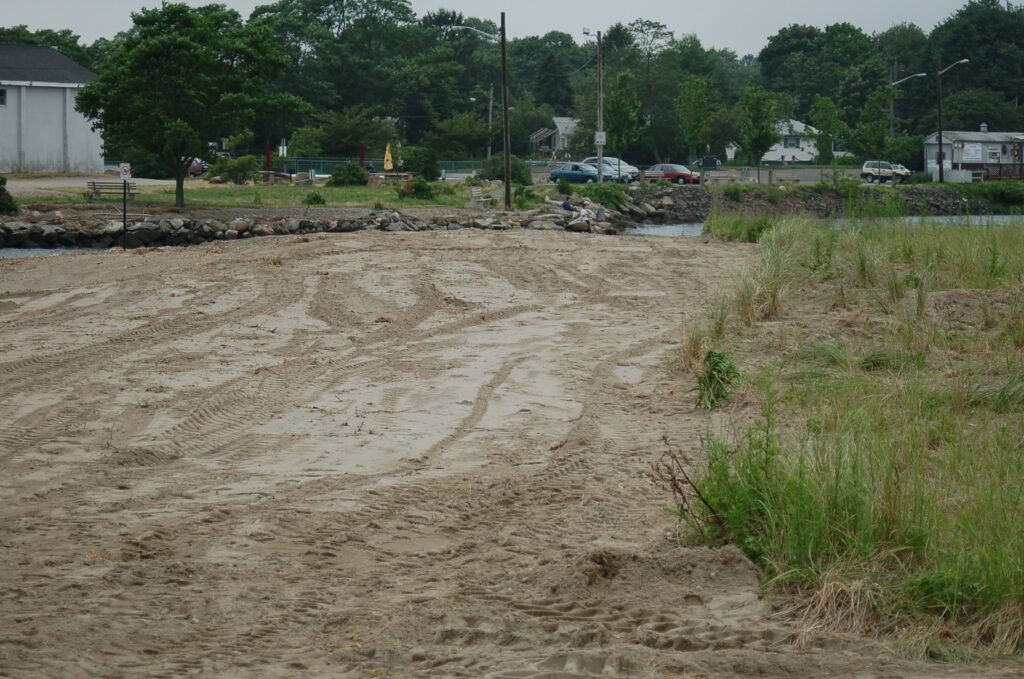HABITAT RESTORATION
Last Friday, June 24, 2011, the City of Bridgeport disturbed part of the habitat restoration at the St. Mary’s sand spit without following the Coastal Area Management (CAM) Review process or notifying the community of their plans. The City is positioning this as a beach clean up and part of an effort to provide more access to the waterfront for its citizens.Some combination of city/citizen collaboration should address access to the waterfront and whether the St. Mary’s sand spit is the proper place for picnic tables, barbecues, and the safety issues that accompany sandy beaches with swift currents. As an environmental organization, whose charter is to protect and preserve the Ash Creek tidal estuary we are not against public use of the sand spit. We are just trying to repair damage that was done to it.
ACCA became involved in restoration of the sand spit due to the destruction caused by the Town of Fairfield over the winter of 2007-2008, when they used the sand spit as a staging area for their dredging operations instead of using a barge, because it is less costly. The heavy equipment destroyed the dunes on the sand spit that are essential to prevent a washover during storms. They had a DEP permit and permission from the City of Bridgeport, but at the end they did not restore the land to its previous condition.
In May 2008, ACCA brought in Save the Sound’s consultant on habitat restoration (Dr. Richard Orson) to make recommendations on habitat repair (click here to see Orson report). Dr. Orson reviewed 2005 aerial photos of the area and concluded that the habitat had been changed from a dune community to a mixed, flat sandy community. The DEP permit had required the land to be restored to previous conditions.
Dr. Orson estimated that it would take about five years for the dune formations to reestablish themselves. It would require bringing in sand and planting beach grass to hold the sand and to accumulate more sand as overwash occurs. The purpose of the beach grass is to create sand dunes. There have been some people in the community who remember the sand spit as being almost all sand and think that the plantings are unnatural and prevent people from enjoying the sand spit. We put up a sign to explain why the beach grass plantings were necessary, but we haven’t done a good enough job explaining this to the public or the City as there is still misunderstanding about it.
We are not trying to create a nature preserve. We are trying to prevent the erosion of the sand spit which protects the Ash Creek tidal estuary (and homes) from flooding and storm surges. If the sand spit is too low in height or smal in size, it ceases to work as a barrier to the Sound and dramatically changes the Ash Creek ecosystem.
The Town of Fairfield accepted the recommendations of Dr. Orson and agreed to bring in one foot of fine beach sand (802 cubic yards). They also supplied the 32,000 beach grass plugs and ACCA arranged for volunteers to plant it (click here to see letter from Town of Fairfield).
The City of Bridgeport removed the picnic tables from the sand spit so that the restoration work could begin. The restoration work began in 2008 and ended in 2009. On May 27, 2009, ACCA along with the Black Rock NRZ met with Charlie Carroll (Bridgeport’s Director of Public Facilities and Parks) and Steve Hladun (Bridgeport Parks & Recreation) to educate them on the need to protect the grass plantings for the next five years and to request that they not put the picnic tables back until then. We encouraged the City to find a more viable location for active recreation because of the safety issues (swift currents, suction of the mudflats) and the fragile dune ecosystem. Light use of the sand spit over the next five years will give it a chance to restore itself. We made sure pathways were created on the sand spit so the public can walk without disturbing the beach grass.
On June 15, 2010 the Town of Fairfield did some more dredging work, but this time they staged it to have little impact on the restoration efforts. On July 18, 2010 the City put picnic tables back on the sand spit despite our request not to do so.
On July 30, 2010 the Connecticut Post reported that two boys had almost drowned off of St. Mary’s sand spit. According to long time residents, this has always been an issue at the sand spit. It has never been a safe place to swim.
The impact of a sandy beach on the eastern side of the sand spit is more of a problem than if it were on the western side, because the storm surges come from the Sound. One long time resident estimates that the eastern side has lost about 50 feet of land due to erosion over the past 60 years. The fine beach sand that was put down can easily wash out with one winter storm. It is doubtful that the City will have the budget to replace that sand each year and even if they did, significant erosion would occur between the time the sand washed out in the winter and could be replaced in the Spring.
Over the many years that the sand spit has been part of Black Rock, it never had picnic tables or barbecue areas. It was a passive recreation area. A change in use of this magnitude should be discussed by the community in an open forum. The City also needs to consider the liability issues involved in creating an “attractive nuisance” that can lead to potential drownings. Finally, the City needs to respect the environmental laws of the State of Connecticut. CAM Reviews are required so that the ecological impact of actions can be assessed BEFORE they cause damage.
At this point the City has not acknowledged the environmental damage done or offered to remediate the damaged habitat. As a result, we are working with the DEP, Save the Sound, and the Connecticut Fund for the Environment to assess the extent of the damage and develop a remediation plan. We have also hired an attorney who specializes in environmental law, Keith Ainsworth, to help us explore our legal options in preventing the City from causing further damage and repair the damage that was done.
Unfortunately, two years’s worth of beach grass growth has been disturbed. We were only three years away from the five year restoration plan when this occurred. It is a set back in the most sensitive area of the restoration, the eastern portion where most of the erosion occurs.
First five photos courtesy of Genevieve Barth.






